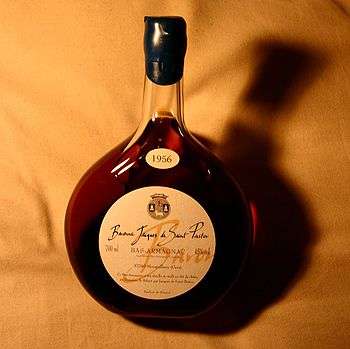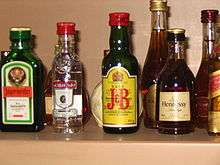Armagnac (brandy)

Armagnac (/ˈɑːmənˌjæk/; French pronunciation: [aʁ.maˈɲak]) is a distinctive kind of brandy produced in the Armagnac region in Gascony, southwest France. It is distilled from wine usually made from a blend of grapes including Baco 22A, Colombard, Folle blanche and Ugni blanc, traditionally using column stills rather than the pot stills used in the production of Cognac. The resulting spirit is then aged in oak barrels before release. Production is overseen by the Institut national de l'origine et de la qualité (INAO) and the Bureau National Interprofessionel de l'Armagnac (BNIA).
Armagnac was one of the first areas in France to begin distilling spirits, but the overall volume of production is far smaller than Cognac production and therefore is less known outside Europe. In addition, it is for the most part made and sold by small producers, whereas Cognac production is dominated by big-name brands.
History and cultural uses
Armagnac is the oldest brandy distilled in France; and, in the past, it was consumed for its therapeutic benefits. In the 14th century, Prior Vital Du Four, a cardinal, wrote that it had 40 virtues:[1][2]
It makes disappear redness and burning of the eyes, and stops them from tearing; it cures hepatitis, sober consumption adhering. It cures gout, cankers, and fistula by ingestion; restores the paralysed member by massage; and heals wounds of the skin by application. It enlivens the spirit, partaken in moderation, recalls the past to memory, renders men joyous, preserves youth and retards senility. And when retained in the mouth, it loosens the tongue and emboldens the wit, if someone timid from time to time himself permits.[3]
Between the 15th and 17th centuries, Armagnac was traded on the markets of Saint-Sever, Mont-de-Marsan, and Aire-sur-l'Adour. Subsequently, Dutch merchants began promoting the trade more widely.
The traditional French gourmet dish ortolan has traditionally been prepared by force-feeding an ortolan bunting before drowning it in Armagnac and roasting it. (The dish is now legally prohibited due to laws protecting the bird.)[4][5]
Geography
The Armagnac region lies between the Adour and Garonne rivers in the foothills of the Pyrenees. The region was granted AOC status in 1936. The official production area is divided into three districts that lie in the departements of Gers, Landes, and Lot-et-Garonne. The region contains 15,000 hectares (37,000 acres) of grape-producing vines.[6] The Fallières Decree of 25 May 1909 describes the three districts:
Each of these areas is controlled by separate appellation regulations. More recently, a new appellation—"Blanche d'Armagnac"—was established to allow the production and export of clear, white brandies that are unaged.[7]
Production
Armagnac is traditionally distilled once, resulting in 52% of alcohol. This results in a more fragrant and flavorful spirit than Cognac, where double distillation takes place. Long aging in oak barrels softens the taste and causes the development of more complex flavours and a brown colour. Aging in the barrel removes a part of the alcohol and water by evaporation (known as part des anges—"angels' tribute" or "angels' share") and allows more complex aromatic compounds to appear by oxidation, which further modifies the flavour. Since alcohol evaporates faster than water, the alcohol degree is naturally reduced by an average of 0.4% per year depending on the characteristics of the cellars (average temperature and humidity). When the Armagnac is considered as matured, it is transferred to large glass bottles (called "Dame Jeanne") for storage. The main difference between Armagnac and other spirits is, that due to its relatively low proof, it is generally not diluted with water.
Armagnac is sold under several classifications, mostly referring to the age of the constituent brandies. Armagnac is allowed to be sold under vintages. When Armagnacs of different ages have been blended, the age on the bottle refers to the youngest component. A three-star, or VS, Armagnac is a mix of several Armagnacs that have seen at least two years of aging in wood. For VSOP, the aging is at least three years, and for XO, at least six. Hors d'âge means the youngest component in the blend is at least ten years old. Older and better Armagnacs are often sold as vintages, with the bottles containing Armagnac from a single year, the year being noted on the bottle.
Grapes
Ten different varieties of Armagnac grapes are authorised for use in the production of Armagnac. Of these, four are most common:
References
- ↑ "France vaunts '40 virtues' of Armagnac". Independent Print Ltd. The Independent. 2010-02-07. Retrieved 4 December 2014.
- ↑ "Armagnac attack". Fairfax Digital. The Age. 2010-03-09. Retrieved 4 December 2014.
- ↑ "Brandy can ward off heart attacks". Associated Newspapers Ltd. Daily Mail (Mail Online). 2007-05-11. Retrieved 4 December 2014.
- ↑ Wallop, Harry (2014-09-18). "Why French chefs want us to eat this bird – head, bones, beak and all". Telegraph Media Group Limited. The Telegraph. Retrieved 4 December 2014.
- ↑ Love, Brian (2014-09-06). "French chefs seek to put banned songbird back on menu". Thomson Reuters. Reuters. Retrieved 4 December 2014.
- ↑ http://le-cognac.com/armagnac/a-propos-de-larmagnac.html
- ↑ "Archived copy". Archived from the original on 2009-02-28. Retrieved 2008-09-23.
External links
| Wikimedia Commons has media related to Armagnac (drink). |
- Cognac and Armagnac—The official website of France (in English)


